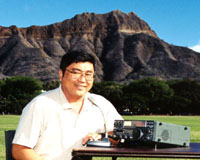 Amateur Radio Articles
Amateur Radio Articles
These are some articles previously written and published by Ron Hashiro, AH6RH. Most have been published in the EARC (Emergency Amateur Radio Club) newsletter "Wireless Dispatch" and may contain a few revisions since the time of original publication. You're welcome to use them with your own amateur radio club newsletter. Please give credit to the EARC Wireless Dispatch.
Enjoy, and feel free to drop me an e-mail if you have any questions.
How Amateurs Accomplish the Impossible
During Disasters
by Ron Hashiro, AH6RH
During Disasters
The media is full of summary reports of how amateur radio operators responding to disasters seem to overcome insurmountable obstacles and accomplish their mission of getting the message through to the destination. Ever wondered why an amateur radio operator has a better chance of getting through when "high technology" radio systems fail?
The answer is very simple. TEAMWORK! As a resource within the community, amateur radio operators are bonded by a brotherhood (sisterhood?) that is simple as the beginning of time...we look out for one another and extend a helping hand in times of dire need.
During a disaster, dozens of amateurs will scan the bands looking for signs of a signal from the handful of hams trapped at the affected scene. When such a signal is found, every resource from outside the affected area will be brought to bear on the signal to establish reliable contact. High-powered amplifiers, directional antennas, sensitive receivers and cross-band radios are just a few of the techniques that hams use to establish and build that reliable contact, conserving precious emergency power for the hams stuck at the disaster scene.
All of this outside teamwork can be thwarted if you and your station is less than par. Good communications is as strong as the weakest link and as the one operating under less than ideal conditions, it is possible that you may wind up as the vital station holding the weakest link. Taking time to stock a few provisions and building up some operator skills will go a long way in performing your end of an "impossible miracle".
1) Make sure you have spare antennas, coax and connector adapters to build or rebuild your station. Even something as inexpensive and unexciting as a j-pole made from 300 ohm TV feeder ladder line will blow away the lame duck performance from any rubber ducky antenna. A ribbon J-pole rolls up nicely into a sandwich bag to put in your backpack, yet can be taped up against a glass window for maximum VHF or UHF performance.
2) Take the time to arrange for emergency power. Marine, wheelchair or RV batteries are favorites for powering 12 volt transceivers but are common enough to be low in cost compared to other emergency power systems.
3) Stock up on alkaline batteries.As hurricane season approaches, be stocked up on alkalines, especially AA and D cells. They are surprisingly cheap at the large discounters such as Sam's Club or Costco. Try to standardize the battery appliances in your home to use either of these two types to get the most for your money.
4) Get an SWR meter or an antenna analyzer. It's hard to transmit full power into an antenna if it isn't a good match. It's best to find out and correct it before you go on the air than to risk damaging your RF finals.
5) Practice your message passing and NCS skills. It's been shown time and time again that a new operator will often need about five net sessions to feel comfortable as a radio operator handling messages. There's a certain rhythm to handling messages or being an NCS. Like learning to ride a bike or play a musical instrument, it's one of these skills that can only be mastered by participation and interaction.
Take advantage of the EARC nightly net to practice running a net as an NCS. It's better to be proficient before an emergency than to pressure out and grow weary as the emergency unfolds. Don't worry about sounding less than 100% when you get started. We've all got started at sometime and each one of us didn't sound polished on Day One. So don't sweat this detail. Give the Net manager a call and sign up.
6) If you've been hemming and hawing about buying a fifty watt VHF or dual-band mobile, here's a good reason. Much of the local communications work during an emergency will be done via simplex work. To be effective from the disaster scene, a mobile with fifty watts will perform much better on simplex overcoming the terrain than a walkie that puts out one to five watts. Here's the perfect excuse (er...reason) to convince your spouse that you really need to bring out the credit card. After all, you are being proactive about the safety and well-being of your family and your neighborhood, of course...
As you can see, it doesn't take much to tip the odds in your favor. Take an assessment of your situation, make a checklist and promise yourself that by the end of the month you'll have these simple things underway. With five NCS sessions under your belt and a few items tucked away you'll feel much better the next time you hear the civil defense sirens sound that you can accomplish "the impossible" rather than be struck with fear and frustration.
Don't delay. Start today!
Permission given to reproduce the above
article in club newsletters provided credit is given
to the author and the EARC
(Emergency Amateur Radio Club) Wireless Dispatch.
Copyright © 1997-2015 Ron Hashiro
Updated: August 31, 2002 DISCLAIMER: Ron Hashiro Web Site is not responsible for the content at
any of the external sites that we link to and therefore
are not necessarily endorsed by us.
